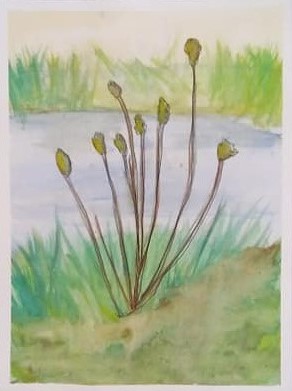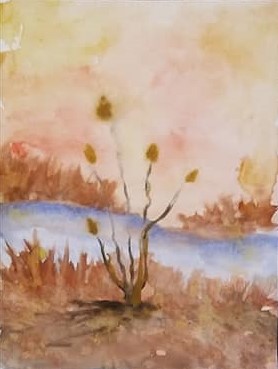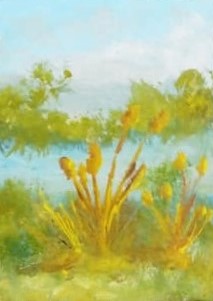As a writer, a musician and an artist, I often draw comparisons between these various disciplines. We find so many elements that link them! Rhythm, harmony, and interpretation are present in both art and music, and ideas of narrative and expression are shared by artists and writers alike.
Today I want to share a few thoughts about a musical correlation to art — taking a theme and making a number of variations upon it — and a fiction-writing correlation — creating a narrative complete with a lead character and a specific setting.
For this learning experience I worked on a series of paintings which were based around a single theme. This theme was built from a strong narrative storyline which expressed a very specific idea — in my head. In other words, the original painting told a very specific story. I don’t know if any of the storyline comes through in the painting, but it was definitely there as I painted.
Here is my original painting. Although it has its flaws, I was pleased with it overall because this was one occasion where I had a clearly-imagined vision, knew exactly how I planned to approach the painting, and achieved the exact results I intended.

The composition is not good, but still I was pleased with the result. It accomplished all that I set out to do. In my mind, at least. You might not hear or see any narrative. You might feel no emotion. This small painting might mean nothing to you. We don’t all react or respond to the same things in art.
Once I’d created my initial work and had established a strong theme, I considered variations I might make. I knew I wanted to paint this scene five different ways, challenging myself to come up with various interpretations of the main theme.
Variation #1 – The Scene in Summer
How would this scene appear if painted in summer instead of winter?

I wasn’t as happy with this one because it takes me to a different time and place — which was the intent, of course — but in doing so, it changes the narrative I sought to create in the original.
Variation #2 – The Scene at Sunset
My next variation involved another change in time, not to a different season but to a different time of day. How would this scene appear at sunset? I’ll be honest here. I hadn’t really thought much about the time of day in my original watercolor. This is something I’m really starting to work on more in my paintings, learning more about using light and shadow.
For my “Sunset Pond” variation, I focused primarily on the colors in the sky.

Here, for some reason, I discontinued the use of ink. I liked the sky and the overall sense of warmth in the painting.
Variation #3 – Impressions of the Scene
My next variation was awful. I wanted to play with various styles, so I attempted to do this in a more impressionist manner. That meant more water, more mess, more blurring and indistinct ideas.

Although I wasn’t happy when I completed this painting, I can look at it now with more objective eyes and see at least a few possibilities there. It’s one more stage in the development of my watercolor abilities.
Variation #4 – The Scene as an Oil Painting
But what if I painted this in oil? That, I decided, would be my next variation on the theme.

At first, as I worked on this little painting – it’s only a 5 x 7 — I wasn’t sure I liked it, but soon my comfort level with oils kicked in, I relaxed, and I began enjoying the creative process. In the end, this bright little painting made me smile. I’m happy with it.
Just for fun, here’s the original theme and all its variations:
I’d love to know which you like best, and I’d love to hear any thoughts you’d like to share about this series of paintings. Does anything suggest a story to you? What, if any, feelings do these paintings evoke?
Doing a series of paintings is an interesting experience, and it’s probably not surprising that the last in the series is my favorite. At that point, I was familiar with both the subject and the story I was telling, plus, of course, I was using my preferred medium. Painting in a series requires us to exercise our imaginative faculties a bit, too, to think of things not as they are but as they might be. I’m sure I’ll be creating other themes and variations in the future. I have many more stories to tell.






Definitely like the first one the best – the background especially is natural and flows well. The last one though does have more dimensionality in the plants in the foreground.
LikeLiked by 1 person
Thanks so much for sharing your thoughts. I like the first one a lot because it turned out the way I’d planned. 🙂 I like the last one, too, because it was oil, and I really do feel more comfortable painting in oil.
LikeLiked by 1 person
These are stupendous! I wish I was half as good as your are! You are terrific! 🙂
LikeLiked by 1 person
Why, thank you so much! I’m learning more each day. 🙂
LikeLiked by 1 person
I like the sunset one best . I really admire the way you set yourself challenges. Well done !
LikeLiked by 1 person
Thank you, Margaret!
LikeLiked by 1 person
Nice paintings, they almost look like botanical sketches.
LikeLiked by 1 person
Thanks so much.
LikeLike